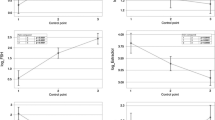Summary
The response of LH and FSH to synthetic gonadotropin releasing factor (GRF) was investigated in 19 patients with malignant germ cell cancers of the testicle prior to radical orchiectomy. The study showed: 1. Patients with circulating beta-HCG presented with increased plasma levels of oestradiol. Base line FSH and response to GRF were significantly decreased. 2. In patients without detectable beta-HCG plasma concentrations of oestradiol and testosterone were within the normal ranges as compared to healthy age matched controls. Base line levels of FSH and LH were increased and an exaggerated response to GRF was observed. From the results of this study it can be concluded that hypergonadotropic dysfunction of pituitary-gonadal axis exists in patients with testicular cancer of germ cell origin. Beta-HCG production by tumour tissue results in hyperoestrogenism and interferes with the pituitary-gonadal axis in terms of inhibition of pituitary gonadotropin release.
Similar content being viewed by others
References
Andres TL, Trainer TD, Leadbetter GW (1980) Atypical germ cells preceeding metachronous bilateral testicular tumors. Urology 15:307–311
Bishop M, Rosenthal ChL (1980) Carcinoma in situ of the testicle. Aktuel Urol 11:82–97
Cochran JS, Walsh PC, Porter JC, Nicholson TP, Peters PC (1974) Clinical evaluation of human chorionic gonadotropin levels in man with testicular tumors. Surg Forum 25:542–543
Eliasson R (1971) Standards for investigation of human semen. Andrologia 3:49–64
Fossa SD, Kleep O, Barth E (1980) Endocrinological studies in patients with metastatic malignant testicular germ cell tumors. Int J Androl 3/5:487–501
Frachimont P, Millet D, Vendrely E, Letawe J, Legros JJy, Netter A (1972) Relationship between spermatogenesis and serum gonadotropine levels in azoospermia and oligozoospermia. J Clin Endocrinol Metab 34:1003–1009
Franchimont P, Legros JJ (1975) Modification of LHRH response under the influence of endocrine equilibrium. In: Motta M, Crosignani PG, Martini L, (eds) Hypothalamic Hormones. Academic Press 311–324
Girard J, Straub J, Baumann JB, Stahl M, Nars PW (1974) Assessment of hypothalamo-anterior pituitary releasing capacity with one single tests. Acta Endocrinol [Suppl] (Copenh) 184–220
Greenwood SM, Goodman JR, Schneider G, Forman BH, Kress SC, Gelb AF (1971) Choriocarcinoma in a man: The relationship of gynecomastia to chorionic somatotropin and estrogens. Am J Med 51:416–422
Guay AT, Tuthill RJ, Woolf PD (1977) Germinal cell aplasia: response of luteinizing hormone (LH), follicle stimulating hormone (FSH) and Testosterone to LH/FSH — releasing hormone with histopathologic correlation. Fertil Steril 28(6):642–654
Isuguri K, Wakabayashi K, Fukutoni K, Takayasu H, Tamasaki B, Okada M (1973) Response of serum luteinizing hormone and follicle stimulating hormone levels to synthetic luteinizing hormone releasing hormone (LHRH) in various forms of testicular disorders. J Clin Endocrinol Metab 37:533–541
Kastin AJ, Schally AV, Guyal C, Arimura A (1972) Release of LH and FSH after administration of synthetic LH releasing hormone. J Clin Endocrinol Metab 34:753–756
Kirschner MA, Cohen FB, Jespersen D (1974) Estrogen production and its origin in men with gonadotropinproducing neoplasma. J Clin Endocrinol Metab 39:112–118
Klassifizierung der malignen Tumoren und allgemeine Regeln zur Anwendung des TNM-Systems (International Union against Chancer), 2. Aufl. Springer, Berlin Heidelberg New York, pp 91–93
Krabbe S, Berthelsen JG, Volsted P, Eldrup J, Skakkeback NE, Eyben FV, Mauritlen K, Nielsen AH (1979) High incidence of undetected neoplasia in maldescended testis. Lancet I:993–1102
Lunglmayr G, Kuber W, Spona J (1981) Endokrine Wechselbeziehungen bei Patienten mit malignen germinalen Hodentumoren. Wien Klin Wochenschr 93(13):611–616
Mecklenburg RS, Sherins RJ (1974) Gonadotropine response to luteinizing hormone releasing hormone in men with germinal aplasia. J Endocrinol Metab 38(6):1005–1008
V z Mühlen A, Köbberling J, Warnecke U, Baiker H (1972) Die Wirkung eines synthetischen “Luteotropen Releasing Faktor” auf die Freisetzung von LH und FSH bei verschiedenen Funktionszuständen der Hypophyse. Dtsch Med Wochenschr 97:432–483
Nuesch-Bachmann IM, Hedinger C (1977) Atypische Spermatogonien als Präcancerose. Schweiz med Wochenschr 107:795–798
Pugh RCB (1976) Pathology of the testis. Blackwell Scientific Publication, Oxford London Edinburgh, p 438
Reiter EO, Kulin HE (1971) Supressed follicle stimulating hormone in men with chorionic gonadotropine secreting testicular tumors. J Clin Endocrinol Metab 33:957–961
Schwarzstein L, De Laboroe NP, Aparicio NJ, Turner D, Mirkin A, Rodriguez NJ, Rodriguez-Lhullier E, Rosner JM (1975) Daily variation of FSH, LH and Testosterone response to intravenous luteinizing hormone releasing factor (LRF) in normal men. J Clin Endocrinol Metab 40:313–319
Skakkebaek NE (1978) Carcinoma in situ of the testis: frequency and relationship of germ cell tumors in infertile men. Histopathology 2:157–163
Spona J, Schneider WHF (1977) Bioavailability of natural estrogens in young females with secondary amenorrhea. Acta Obstet Gynecol Scand Suppl 65:33–38
Spona J (1978) Bestimmung und Auswertung der Prolaktinspiegel und des Wachstumshormons. In: Bromocriptin, Geyer G (ed) Sandoz-Ges., Wien Austria, pp 43–55
Spona J, Lunglmayr G (1974) Physiologie des hypophysärtestikulären Regulationssystems des Mannes: radioimmunologische Hormonuntersuchungen. Wien Klin Wochenschr 86: 311–315
Stepanas AV, Samaan NA, Schultz PN, Holoye PY (1978) Endocrine studies in testicular tumor patients with and without gynecomastia A report of 45 cases. Cancer 41:369–376
Walsh PC (1976) The Endocrinology of Testicular Tumors. In: Grundmann E, Wahlensieck W (eds) Tumors of the Male Genital System. Rec Prog Cancer Res 60:169–178
Wang CF, Lasley BL, Yen SSC (1975) The role of estrogen in the modulation of pituitary sensitivity of LRF (luteinizing hormone releasing factor) in man. J Clin Endocrinol Metab 41:41–43
Author information
Authors and Affiliations
Rights and permissions
About this article
Cite this article
Lunglmayr, G., Kuber, W., Kratzik, C. et al. The gonadotropin response to synthetic gonadotropin releasing factor in patients with testicular cancer. Urol. Res. 11, 69–73 (1983). https://doi.org/10.1007/BF00256950
Accepted:
Issue Date:
DOI: https://doi.org/10.1007/BF00256950




